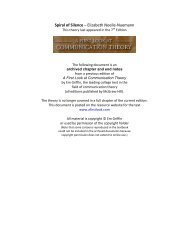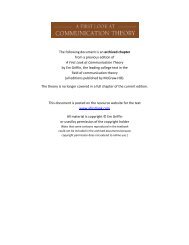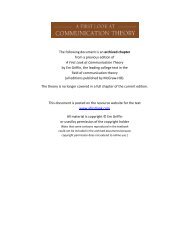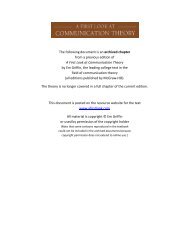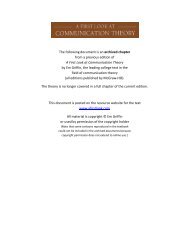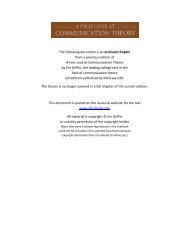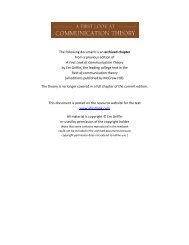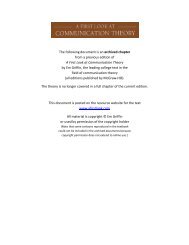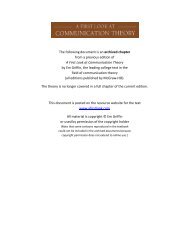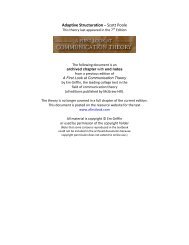Attribution Theory of Fritz Heider - A First Look at Communication ...
Attribution Theory of Fritz Heider - A First Look at Communication ...
Attribution Theory of Fritz Heider - A First Look at Communication ...
You also want an ePaper? Increase the reach of your titles
YUMPU automatically turns print PDFs into web optimized ePapers that Google loves.
ATTRIBUTION THEORY 145<br />
3. Wh<strong>at</strong> steps could you take to make certain th<strong>at</strong> you don’t commit the<br />
fundamental <strong>at</strong>tribution error?<br />
4. According to <strong>at</strong>tribution theory, wh<strong>at</strong> is it th<strong>at</strong> we <strong>at</strong>tribute to other<br />
people?<br />
A SECOND LOOK<br />
Recommended resource: Kelly G. Shaver, An introduction to <strong>Attribution</strong> Processes,<br />
Lawrence Erlbaum Associ<strong>at</strong>es, Hillsdale, N.J., 1983.<br />
Original conception: <strong>Fritz</strong> <strong>Heider</strong>, “Social Perception and Phenomenal Causality,”<br />
Psychological Review, Vol. 51, 1944, pp. 358-374.<br />
Fuller development: <strong>Fritz</strong> <strong>Heider</strong>, The Psychology <strong>of</strong> Interpersonal Rel<strong>at</strong>ions, John Wiley<br />
& Sons, New York, 1958.<br />
Fundamental <strong>at</strong>tribution error: L. D. Ross, “The Intuitive Psychologist and His<br />
Shortcomings: Distortions in the <strong>Attribution</strong> Process,” in Advances in Experimental<br />
Social Psychology, Vol. 10, Leonard Berkowitz (ed.), Academic Press, New York, 1977,<br />
pp. 173-220.<br />
Rel<strong>at</strong>ional <strong>at</strong>tributions: John H. Harvey, Terri L. Orbuch, and Ann L. Weber (eds.),<br />
<strong>Attribution</strong>s, Accounts, and Close Rel<strong>at</strong>ionships, Springer-Verlag, New York, 1992.<br />
Altern<strong>at</strong>ive approach to person perception: Mary K. Babcock, “The Dram<strong>at</strong>urgic<br />
Perspective: Implic<strong>at</strong>ion for the Study <strong>of</strong> Person Perception,” European Journal <strong>of</strong> Social<br />
Psychology, Vol. 19, 1989, pp. 297-309.<br />
Self-perception principle: Daryl Bern, “Self-Perception <strong>Theory</strong>,” in Advances in Exper-<br />
imental Social Psychology, Vol. 6, Leonard Berkowitz (ed.), Academic Press, New York,<br />
1972, pp. 2-62.<br />
Heartbe<strong>at</strong> study: S. Valins, “Cognitive Effects <strong>of</strong> False Heart-R<strong>at</strong>e Feedback,”<br />
Journal <strong>of</strong> Personality and Social Psychology, Vol. 4, 1966, pp. 400-408.<br />
Research upd<strong>at</strong>es: J. H. Harvey, W. Ickes, and R. F. Kidd (eds.), Nezu Directions in<br />
<strong>Attribution</strong> Research, Vols. l-3, Lawrence Erlbaum Associ<strong>at</strong>es, Hillsdale, N.J., 1976,<br />
1978, 1981.<br />
Further extensions: J. H. Harvey and Gifford Weary (eds.), <strong>Attribution</strong>: Basic Issues<br />
and Applic<strong>at</strong>ions, Academic Press, San Diego, 1985.<br />
Jury psychology: Gerald Miller, “Social Cognition, the Unwanted Juror?’ in Social<br />
Cognition and Communic<strong>at</strong>ion, Michael Rol<strong>of</strong>f and Charles Berger (eds.), Sage, Beverly<br />
Hills, Calif., 1982, pp. 227-254.<br />
Jury simul<strong>at</strong>ion research: Wayne Weiten and Shari S. Diamond, “A Critical Review<br />
<strong>of</strong> the Jury Simul<strong>at</strong>ion Paradigm: The Case <strong>of</strong> Defendant Characteristics,” Law and<br />
Human Behavior, Vol. 3, 1979, pp. 71-93.



